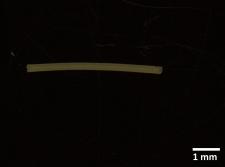Pharmacy: Using starch as a novel drug transporter?

Many active pharmaceutical ingredients are difficult to administer at present as they are poorly absorbed by the body and break down too quickly. These problems can be overcome by drug delivery systems, which release active substances in the body in a controlled manner over a prolonged period of time. An example of one such application are drug-delivery implants. Once injected, the body degrades them over a longer period of time and the desired substance is released. This technology is already being used to treat diseases like cancer and bacterial infections.
Most currently used drug delivery systems are based on polylactide-co-glycolide (PLGA) and polylactide (PLA). However, these materials have several disadvantages: "When PLGA and PLA degrade in the body, they create an acidic environment which results in an irregular release of the substances. Optimal treatment would, of course, involve a controlled release. The acidic environment can cause local inflammation and also inactivate drugs prior to their release." explains Professor Karsten Mäder from the Institute of Pharmacy at MLU. His team has been working for many years on improving existing drug systems and developing new alternatives.
In the current study, the researchers investigated starch as a possible excipient. "Starch could provide an alternative for PLGA and PLA because it is already widely used as an excipient in medicinal products and medical devices," Mäder adds. The researchers used a special pharmaceutical-grade starch in their experiments. Rod-shaped implants were created using a special extrusion process. Earlier studies by the team had already confirmed that starch is a suitable carrier substance for the controlled release of drugs. For the current study, the researchers tested the rods in mice. They were able to show that the new system works particularly well for poorly water-soluble drugs, as it releases them continuously over several weeks. There were also no side effects and the starch implant degraded completely.
"Our study shows that special starches could be used in drug delivery systems," concludes Mäder. However, before this invention could be applied to humans, large-scale clinical studies on its efficacy and safety would need to be conducted.
The study was funded by the European Social Fund and the state of Saxony-Anhalt.
Study: Esfahani G. et al. A starch-based implant as a controlled drug release system: Non-invasive in vivo characterization using multispectral fluorescence imaging. Journal of Controlled Release (2023). doi: 10.1016/j.jconrel.2023.05.006

